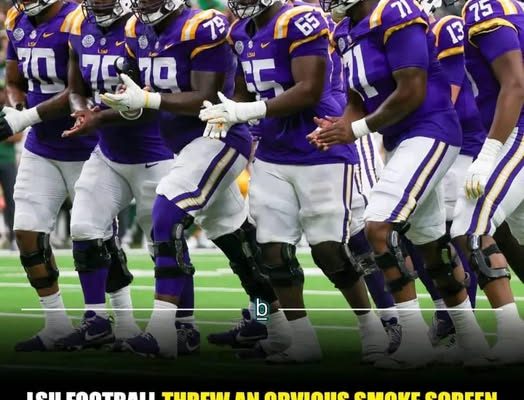LSU genuinely believes it can compete for a national title during the 2025 college football season, and the optimism in Baton Rouge is not without merit. The Tigers have the pedigree, the coaching staff, the culture, and the skill-position firepower that has historically defined national champions in the modern era of college football. Yet, like many programs that dream of hoisting the trophy in January, there is one glaring area that may undermine all of that hope: the offensive line. The trenches have long been the separator between programs that flirt with greatness and those that truly capture it, and for LSU, 2025 could serve as the ultimate test of whether elite talent at quarterback, receiver, and defense can compensate for uncertainty at the line of scrimmage.
The confidence surrounding LSU begins with the belief in its roster composition. The Tigers have recruited well in recent years, consistently ranking among the top 10 nationally in recruiting classes. Their depth chart features highly ranked quarterbacks, explosive wide receivers, and a stable of running backs who can produce in both traditional and spread looks. Defensively, LSU boasts a combination of speed and strength that is emblematic of SEC dominance. The linebacker corps is dynamic, the secondary is fast and aggressive, and the defensive line can generate pressure. These ingredients form the foundation of a championship contender. But championships are not just won with talent; they are won with balance, durability, and the ability to control games in the moments when finesse gives way to brute force.
The SEC is the most grueling conference in the sport, and one of its defining features has always been the quality of its offensive and defensive lines. Programs like Alabama and Georgia, who have dominated the landscape for much of the past decade, have consistently invested in building offensive lines that not only protect their quarterbacks but also wear down opponents over four quarters. LSU, historically, has produced dominant linemen as well, but the current perception is that the Tigers may not have the kind of elite, NFL-ready talent in the trenches that is required to win against the very best. The offensive line is functional, certainly capable of winning games against average opponents, but the fear is that against top-tier defenses—programs like Georgia, Alabama, and Michigan—the cracks will show.
In college football, the offensive line is often overlooked because fans and analysts tend to focus on the stars with the football in their hands. Quarterbacks and receivers dominate highlight reels, running backs get the headlines, and defensive playmakers are glorified for game-changing turnovers. But those stars rarely shine without the unglamorous, grinding effort of the offensive line. For LSU in 2025, the storyline is shaping up to be whether its line can hold up long enough for its playmakers to operate. A quarterback with elite talent is worthless if he’s constantly hurried, sacked, or forced to throw under duress. A wide receiver’s speed is irrelevant if the quarterback has no time to deliver the ball. And a running back’s power or vision does little good if the first contact comes behind the line of scrimmage.
What makes LSU’s case interesting is that the Tigers are not short on confidence. Head coach Brian Kelly and his staff have instilled a culture of belief, emphasizing discipline, preparation, and resilience. The team points to its recent recruiting hauls as evidence that the gap is narrowing with the SEC’s most dominant forces. Players themselves have echoed that sentiment, noting that the locker room atmosphere is one of determination and hunger. This is not a team entering the season merely hoping to compete—it is entering expecting to compete. Yet optimism does not erase the technical deficiencies that exist in certain units. Coaches and fans alike know that when the Tigers face elite competition, the spotlight will shine brightest on the offensive line.
One of the underlying issues is that offensive line development takes time. Unlike skill players, who can often contribute immediately as freshmen or sophomores, linemen usually require two to three years in a strength and conditioning program before they can compete at an elite level. They need to add size, build functional strength, and learn the intricacies of technique and footwork. LSU has recruited capable linemen, but it is not clear if enough of them have matured into the kind of unit that can withstand the onslaught of top-tier defensive fronts. Georgia, for example, has made it a priority to not only recruit but also retain and develop offensive linemen, resulting in units that dominate physically year after year. LSU has not quite reached that consistency, and the 2025 season could expose those growing pains.
Another factor is depth. Injuries are an inevitable part of football, and the offensive line is particularly vulnerable due to the physicality of the position. A team with elite depth can absorb those injuries without significant drop-off, but a team that lacks it can see its season unravel quickly. LSU’s top-line starters may be sufficient, but the drop-off to the backups could be stark. In a long SEC schedule, where the Tigers will face defensive fronts designed to punish linemen every week, that lack of depth could prove costly.
It is also worth noting that LSU’s offensive scheme puts pressure on the line in ways that some other programs do not. The Tigers like to push the ball downfield and use tempo, which requires linemen to both protect in long-developing pass plays and maintain stamina in high-speed sequences. These demands magnify any shortcomings in protection or conditioning. Against teams with deep defensive rotations, LSU’s line could wear down, leading to breakdowns late in games.
Still, LSU’s hopes are not misplaced. College football history is filled with examples of teams overcoming deficiencies at certain positions because of overwhelming strengths elsewhere. A truly elite quarterback can mask offensive line struggles by getting the ball out quickly, extending plays with mobility, or simply making throws under pressure that few others can. LSU has the kind of talent at quarterback to potentially do just that. Paired with receivers who can create separation and make plays after the catch, the Tigers could mitigate their offensive line concerns through scheme and execution. Quick passing concepts, creative play-calling, and strategic use of running backs in protection can all help to hide weaknesses.
The defense, too, could play a role in lessening the burden on the offensive line. If LSU’s defense can dominate games, create turnovers, and provide short fields, the offense won’t be forced into long drives that put maximum pressure on the line. Complementary football, where all three phases contribute, is the hallmark of champions, and LSU has the potential to achieve it. The key will be consistency—avoiding games where the line becomes such a liability that it derails everything else.
The SEC is unforgiving, and LSU’s path to the national title will inevitably run through programs with elite defensive lines. Alabama’s pass rushers are perennially among the nation’s best. Georgia’s front seven is loaded with five-star talent and disciplined enough to exploit any weakness. Even programs like Texas, now fully integrated into the SEC, will bring size and depth in the trenches. LSU cannot escape these matchups; it can only prepare for them. That preparation will determine whether its championship dreams are realistic or illusory.



